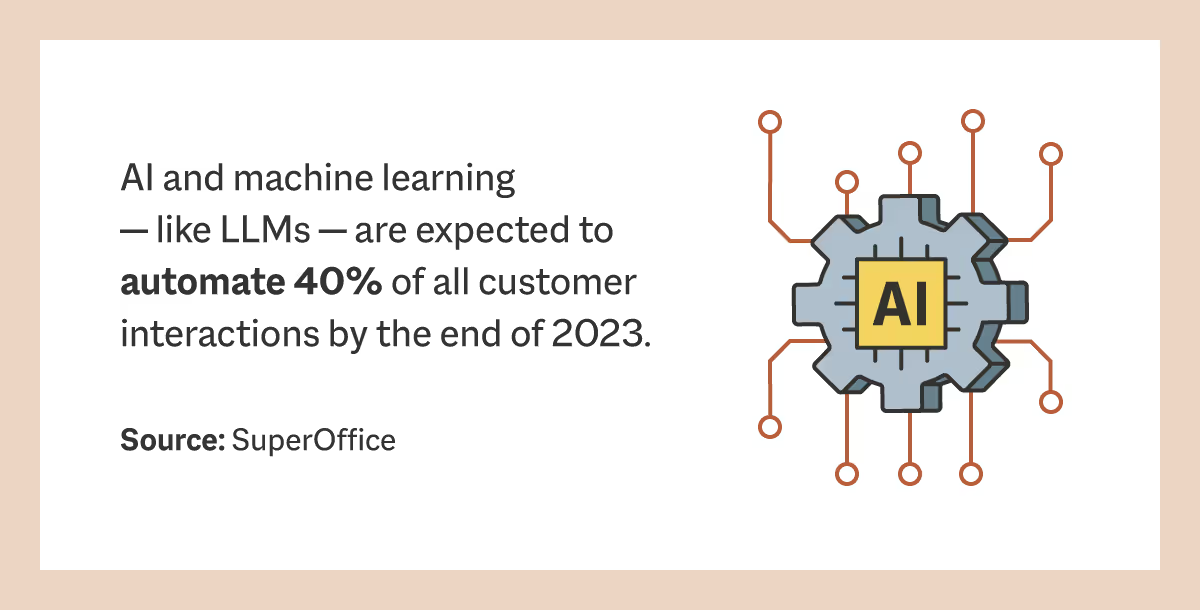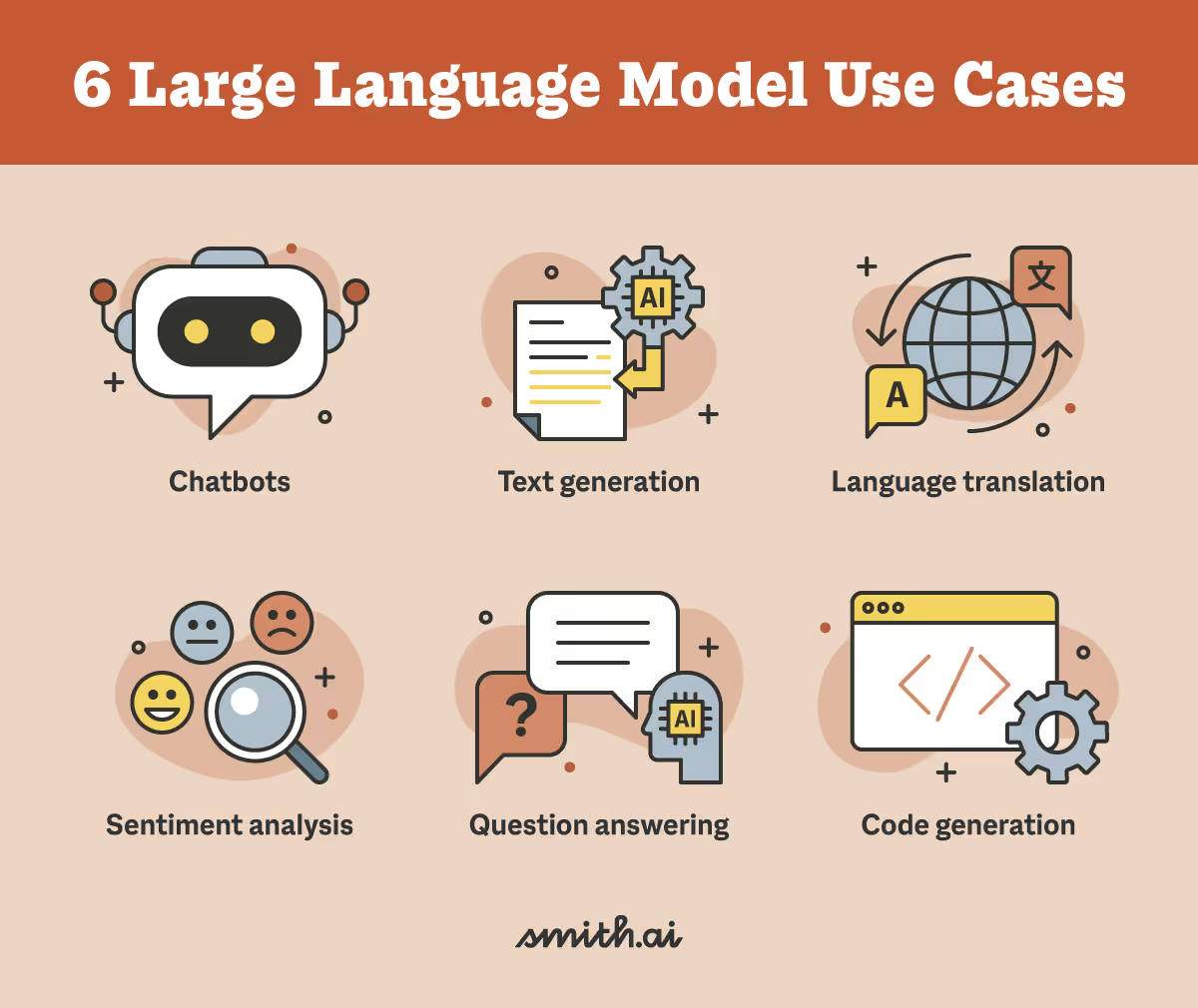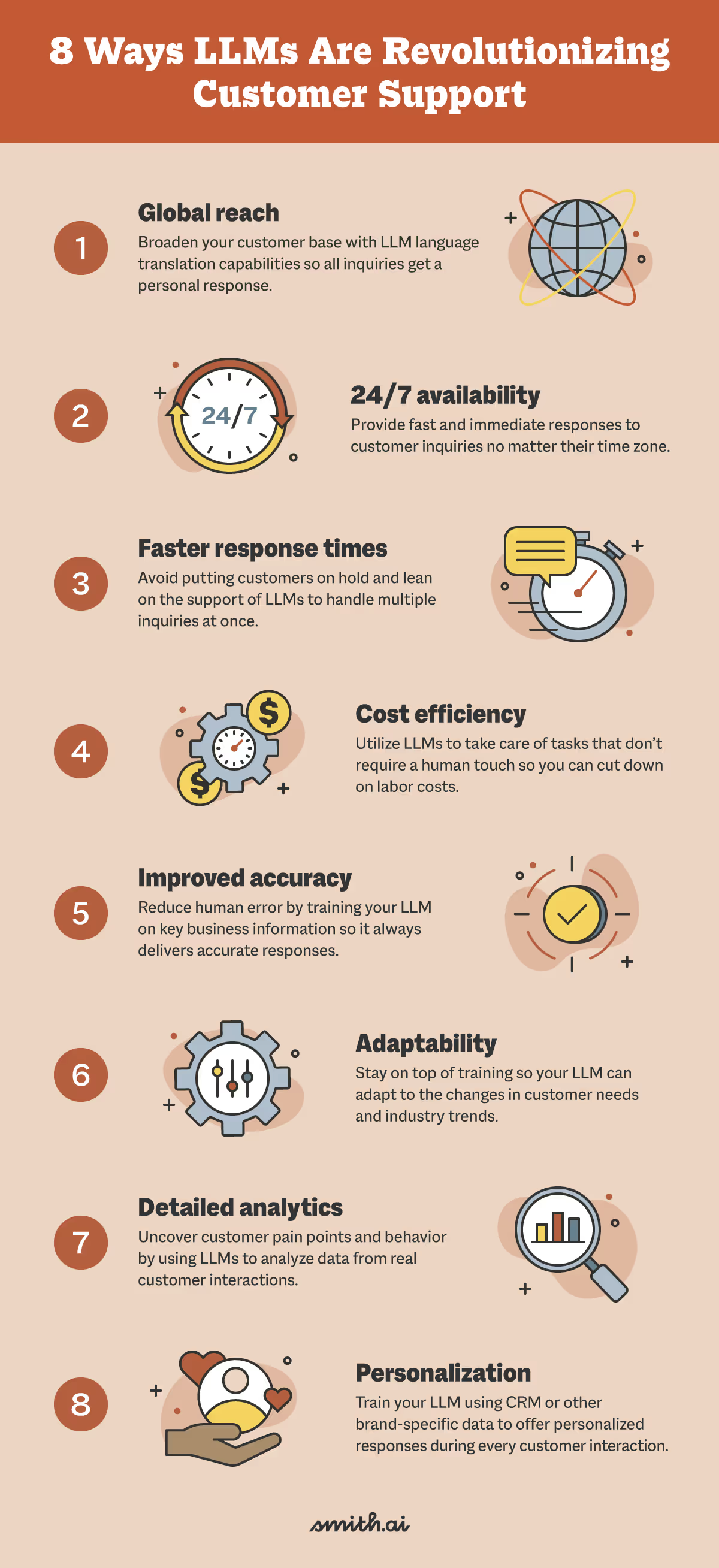Large Language Models (LLMs): Definition, Examples, and Benefits
Large Language Models (LLMs): Definition, Examples, and Benefits

Year after year, technology continues to evolve, and it’s making a big impact on the customer service industry. Large language models (LLMs) are transforming the way companies interact with their customers — offering an automated but personalized approach to customer support tasks.
It’s estimated that AI and machine learning are used to automate around 40% of all customer interactions. Our AI Chat and AI Receptionist solutions help facilitate these interactions and enhance customer experiences.
In this guide, we’ll demystify LLMs so you can understand how they work, what they’re used for, and how you can put them to use for your customer support team.
What are large language models (LLMs)?
A large language model uses artificial intelligence to perform natural language processing (NLP) tasks like translation, text generation, question answering, and sentiment analysis. If you’ve heard of (or used) ChatGPT, then you may understand the foundation of LLMs.
LLMs use deep learning — a complex type of AI-based machine learning — to process data in a way that closely resembles natural, human-like interactions. LLMs allow computers to understand, manipulate, and generate human language text.
As they’ve become more and more advanced, many teams have started allowing LLMs to streamline and automate even their human-facing processes.
Not only can LLMs handle repetitive routine tasks like appointment scheduling or FAQs, but they can also handle tasks like logical decision-making and appropriately route callers to the right representative. This is because LLMs have access to a massive quantity of data, making them useful for both routine and advanced tasks.

Generative AI vs. LLMs
Generative AI refers to a broad category of artificial intelligence models that can create many different forms of content and information, like text, code, audio, and images —- all based on user input data.
LLMs are a type of generative AI model focused on NLP tasks — those that involve understanding and generating human language text, like translations or summarizations.
You can think of image generators like Midjourney as a generative AI tool, but tools like ChatGPT would be considered generative AI and use LLMs.
How do LLMs work?
LLMs are built using what’s called transformer-based architectures. A transformer is a type of “neural network” architecture (yes, like a brain) designed by Google.
This network is composed of multiple layers, all of which work together to break down text into smaller pieces like words or characters, called tokens, to determine the relationship and meaning between each token.
The network tries to identify patterns in sequential data (like words that come after one another in a sentence) to extract context and meaning from them.
One layer within the neural network of LLMs consists of attention mechanisms. These allow the model to focus on specific parts of text to understand their context and sentiment. This helps the model formulate a human-like response based on a user’s input.
You can imagine a transformer architecture like a newborn’s brain — it takes in a stimulus and naturally starts identifying patterns and forming connections, hence the term “neural network.”
How are LLMs trained?
LLMs go through a vigorous “training” process where humans feed them large amounts of data to teach them how to understand and generate language. Just as a newborn listens to sounds adults make and tries to make sense of it all, LLMs do so in a much more complex way.
LLMs are trained on massive datasets of text, like books, articles, and even conversations, but then must be fine-tuned to provide tailored results depending on the task at hand.
The LLM training process goes through two key phases: pretraining and fine-tuning.
- Pretraining: The first phase involves training the LLM on a large and diverse dataset. This type of data can be pulled from the internet and may include information from social media, books, articles, and websites. This is where the model starts to understand the relationships between different tokens.
- Fine-tuning: The next phase involves supervised learning in which humans provide the model with additional datasets that enable it to perform better based on a specific task. For example, you can train your LLM on your product offerings or specific brand-related prompts and answers. This allows your LLM to easily adapt to different NLP tasks.
This two-step training process ensures your LLM can understand different inputs and generate the most accurate information for your customers.
Examples of LLMs
Whether you know it or not, you’ve probably heard of LLMs and maybe even used them to help rewrite an email, brainstorm new ideas, or generate a blog post.
Let’s dive into a few of the most popular LLMs you may already be familiar with:
GPT-3
GPT-3, which stands for Generative Pre-trained Transformer 3, is currently the standard LLM model. However, you may have also heard of GPT-4, another LLM model with an even larger database than GPT-3. One of the most popular LLM tools — ChatGPT — is trained on GPT-3.
ChatGPT is an AI chatbot developed by OpenAI that provides users with responses based on their inputs. Aside from providing complex, human-like responses, ChatGPT keeps a log of your conversations to reference and inform future dialogue — just as (if not much better than) the human brain naturally would.
BERT
BERT (Bidirectional Encoder Representations from Transformers) is another popular LLM developed by Google. It was created to improve the comprehension of natural language nuances and can be used for an array of NLP tasks. BERT is trained to grasp and anticipate words and sentences that mimic natural language.
BERT can be applied to many applications but is most commonly known for its application on Google’s search engine. BERT uses natural language processing and sentiment analysis to tailor Google’s search engine results so that they relate better to a user's query. Before LLMs, computers weren’t able to comprehend the sentiment behind a query, but they can now better understand user intent and provide more accurate search results.
LaMDA
LaMDA (Language Model for Dialogue Applications) — one of Google’s conversational LLMs — was designed to improve conversational interactions. Google used human dialogue to train LaMDA so it has the capability to engage in natural, relevant, open-ended conversations.
In February 2023, Google announced the first version of Bard, its conversational AI tool powered by LaMDA. Similar to ChatGPT, you can input a prompt into Bard and it will output a response using the information it’s trained on. It can generate creative ideas and content and has language translation capabilities. Technology quickly evolves, and since first announcing Bard, Google has released another LLM model called PaLM2, which now powers Bard.
LLM use cases

LLMs can be trained to perform a variety of natural language processing tasks. Here are a few non-exhaustive examples to paint a picture of the different ways you can use LLM-powered tools.
- Chatbots and conversational AI: LLM-powered chatbots and conversational AI can engage in natural conversations with the ability to properly decipher their input and provide a natural response in return. Similar to Smith.ai’s AI chat, customers can ask questions, and the chatbot can output accurate and fast responses. This provides personalized customer interactions every time.
- Text generation: Whether you’re writing blog posts, emails, or product descriptions, LLMs can generate short or long-form, human-like copy. They have the ability to summarize large chunks of text and can even rewrite and paraphrase text that a user inputs.
- Language translation: LLMs can be trained to understand nearly any language, making it quick and easy to translate documents or conversations.
- Sentiment analysis: LLMs can detect and analyze emotion and tone in text, determining whether it’s positive, negative, or unbiased. This can be helpful when trying to understand the intent of a customer’s response so you can find a solution or route them to the appropriate department.
- Question answering: Due to their large information databases, LLMs can formulate answers to complex questions. This can improve efficiency among sales teams and customer service representatives, for example, as they’re able to quickly provide customers with the right information.
- Code generation: LLMs can be trained to generate or tweak code based on a user’s input. For example, they can detect bugs within lines of code or help a user formulate code based on the instructions and details they provide the model.
8 ways LLMs can enhance customer support

Now that we’ve covered the basics of LLMs and their general use cases, let’s dive into the specific ways LLMs can improve your customer support teams and enhance the overall customer experience.
- Global reach: Because LLMs can understand, support, and translate multiple languages, it allows you to broaden your customer base. No matter where a customer is located or what language they speak, LLM technology can provide them with the answers they need without any hassle.
- 24/7 availability: LLM-powered chatbots and voice assistants give your customers access to 24/7 support. They no longer have to wait to be transferred to different representatives or call during hours of operation to get an answer. LLMs provide fast and immediate responses no matter the time of day or time zone.
- Quicker response time: Because LLMs can respond to multiple customer inquiries at once, they greatly improve response times. Gone are the days of long wait times that lead to frustrated customers. This also allows businesses to scale at greater rates.
- Cost efficiency: LLMs can handle not only a large number of inquiries but also a vast number of routine tasks that can be done without human involvement. Because of this, you’ll be able to significantly reduce human resource costs.
- Improved accuracy and consistency: Because LLMs can be trained on the ins and outs of your business, they can provide the most accurate information — reducing human error and presenting your customers with consistent responses.
- Adaptability: LLMs can be trained to adapt to any changes in customer needs, product offerings, and industry trends. This ensures their responses reflect the most accurate information and meet the current needs of customers.
- Personalization: LLMs can scrape customer data from your website, CRM, or other support materials to provide customers with personalized responses tailored to their unique needs, ultimately improving satisfaction.
- Analytics and insights: LLMs can provide valuable insight into customer pain points, behavior, and preferences by collecting and analyzing data from customer interactions. These insights use sentiment analysis to uncover how customers feel about your brand, allowing you to make informed business decisions and identify areas for improvement.
Harness the power of LLMs with Smith.ai
LLMs are transforming the future of customer support. Their personalized and immediate responses save your team time and resources while helping increase customer loyalty.
At Smith.ai, we use LLMs to power our AI Receptionist and Web Chat solutions to help answer inbound calls & chats, qualify leads, and offer 24/7 customer support with accuracy and efficiency. Our live, virtual receptionists are also available around the clock to step into the conversations when complex or sensitive issues arise, so you can rest assured knowing a human is always there to help.
For more information, visit https://smith.ai/booking.
Take the faster path to growth. Get Smith.ai today.
Key Areas to Explore
Technical Implementation Terms
Voice user interface (VUl) design
Speech recognition integration
Text-to-speech optimization
API connectivity and webhooks
Real-time data synchronization

Your submission has been received!














.svg)



